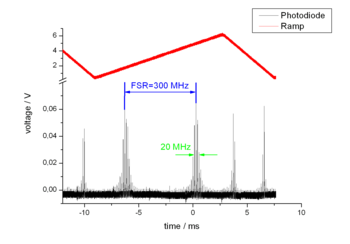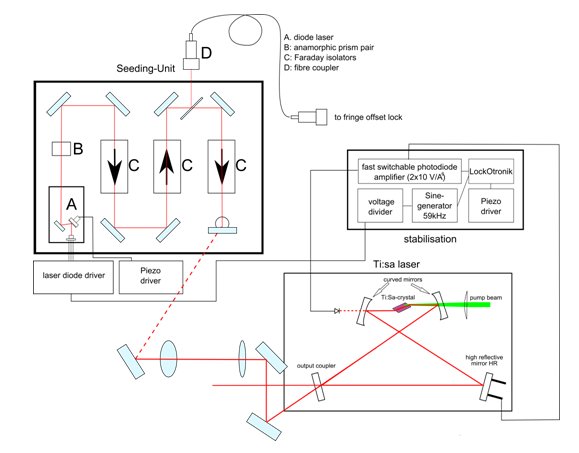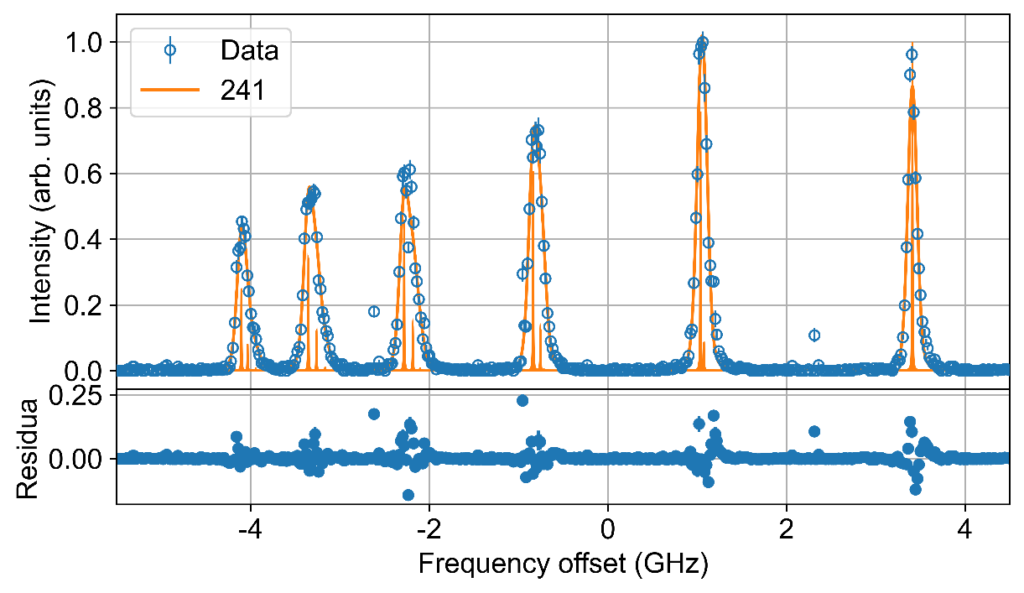The pulsed Ti:Sa lasers, which were developed by the workgroup LARISSA, have a first-rate beam profile and a large pulse-power. A wide wavelength band can easily be accessed. However, they are not suited for applications that demand a narrow spectral width because of their pulse characteristic.
A so-called injection procedure, on the other hand, allows for the lasers to reach a Fourier-limited bandwidth of about 20 MHz. For this purpose the light of a narrow-band diode laser is coupled to the resonator of the Ti:Sa laser. With this setup, the photons of the diode laser will be amplified instead of a spontaneous emitted photon of the Ti:Sa crystal. The emitted laser light will now have the characteristics of the Ti:Sa lasers concerning time and power, but will take on the spectral characteristics of the diode laser. Because of the high pulse power, the seeded Ti:Sa laser can be frequency doubled, tripled or quadrupled with the help of a nonlinear crystal.

Setup
In principle the setup can be divided into three components. As master laser acts a diode laser, an anamorphic pair of prisms and three optical isolators. Using a telescope the output of the master laser is injected into the resonator of the slave laser (Ti:Sa laser). This resonator is build in the Bowtie geometry. The Ti:Sa crystal is placed between two curved mirrors; the resonator is enclosed by a highly reflective mirror on a piezo actuator and an output coupler. The third part of the setup deals with the stabilisation. It constantly keeps the length of the resonator on an integral multiple of the wavelength of the diode laser. At the same time, the frequency of the diode laser is being modulated. The stabilised signal is recorded behind one curved mirror with a photodiode. With the help of a standard lock-in technique and a PID-controller the length of the resonator is stabilised with the piezo actuator.
Currently, in collaboration with Nagoya University, a widely tunable cw-Ti:Sa laser is being built, which was developed by Volker Sonnenschein (https://doi.org/10.1016/j.nimb.2019.03.017). One advantage over the diodes used so far is that a single master laser covers the entire possible wavelength range of the seeded laser and provides high output power. The laser is pumped by 4 diodes, two of each having a wavelength of about 465 nm and 520 nm. Compared to commercial Ti:Sa cw-lasers, this one is characterised in particular by a cost-effective purchase price and allows strong user interaction.

Applications in high resolution spectroscopy
Due to their narrow band width, the seeded Ti:Sa laser is the ideal instrument for high resolution spectroscopy. The advantages compared to other narrow band width laser systems are the variable wavelength range and high pulse power.
The data in the picture below were taken using the new developed cw-Ti:Sa laser for the first time. It clearly shows the possibilities for laser spectroscopy and thus motivates continuous further developments.

Application as a laser ion source
The standard Ti:Sa laser only allows an element specific ionisation. A seeded Ti:Sa laser enables a isotope or isomer specific ionisation. This allows for a more targeted selection for the production of ions for experiments.